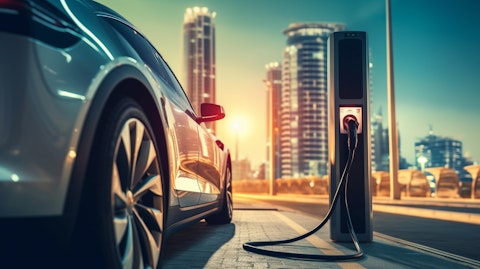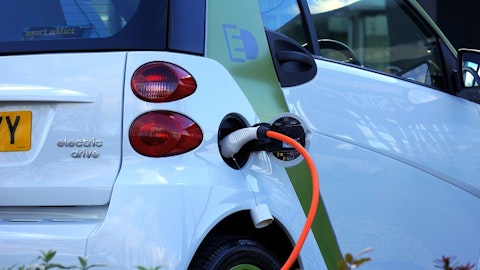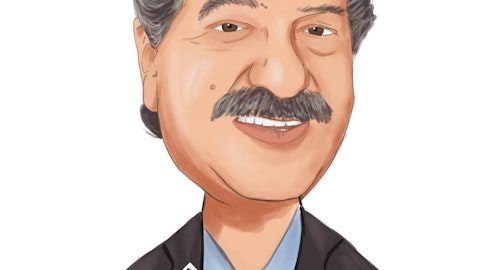GreenPower Motor Company Inc. (NASDAQ:GP) Q3 2024 Earnings Call Transcript February 13, 2024
GreenPower Motor Company Inc. misses on earnings expectations. Reported EPS is $-0.17 EPS, expectations were $-0.14. GP isn’t one of the 30 most popular stocks among hedge funds at the end of the third quarter (see the details here).
Operator: Good day, and welcome to the GreenPower Motor Company Third Quarter Earnings Conference Call. [Operator Instructions] Please note, this event is being recorded. I would now like to turn the conference over to Michael Sieffert, Chief Financial Officer. Please go ahead.
Michael Sieffert: Thank you. This is Michael Sieffert, the Chief Financial Officer of GreenPower Motor Company. I would like to welcome everyone to our call to discuss GreenPower’s results for the three and nine month periods ended December 31, 2023, and recent developments. I’m here today with our Chief Executive Officer, Fraser Atkinson; and our President, Brendan Riley. During today’s call, we may make comments or statements about our future expectations, plans and prospects which may constitute forward-looking statements for the purpose of the safe harbor provision under the Private Securities Litigation Reform Act of 1995 and applicable Canadian securities laws. Actual results may differ materially from those indicated by these forward-looking statements as a result of various important factors, including those discussed in our quarterly interim results and MD&A filed on SEDAR and on EDGAR.
In addition, these forward-looking statements relate to the date on which they are made. We anticipate that subsequent events and developments may cause the company’s views to change. GreenPower disclaims any intention or obligation to update or revise any forward-looking statements, whether as a result of new information, future events or otherwise. Also, during the course of today’s call, we may refer to certain non-IFRS financial measures. Reconciliation of these non-IFRS measures can be found in our MD&A filed on SEDAR and on EDGAR and is also located on our website at www.greenpowermotor.com. I’ll now pass the call over to Fraser Atkinson, GreenPower’s CEO, to discuss highlights for the quarter.
Fraser Atkinson: Good morning, and thank you for joining GreenPower’s quarterly earnings call today. Our School Bus group continued to make great strides in the third quarter. We achieved a significant milestone with the delivery of 4 Type A Nano BEAST school buses that were the first all-electric purpose-built school buses manufactured in West Virginia. Immediately following that delivery, production of the Type D BEAST school bus began in the West Virginia plant, which in the immediate term, will fulfill current orders for 38 BEAST school buses in West Virginia and prepare the production team for the mix manufacturing of BEASTS and Nano BEAST at the facility to meet the projected demand. Presently, we have live orders for 102 of our Type D Mega BEAST, BEAST and Type A Nano BEAST school buses, including our first order from our dealer in the state of New York.
We also have the qualified sales pipeline for 164 GreenPower school buses. On the commercial vehicle side of the business, we had deliveries this quarter that included 10 EV Star Cab and Chassis to the Canadian unit of a global retailer who will upfit the vehicle for fulfillment of their orders to customers in the Greater Toronto market. Having said that, our commercial vehicle group with EV Star Cargo and EV Star passenger vehicles is several quarters behind the school bus group in terms of its order book. We expect to achieve similar growth with live orders, purchase orders and a qualified sales pipeline by leveraging new and existing incentive programs as well as third-party relationships. We’ve had delays from customers with deliveries of our EV Star Cab and Chassis, with inventory ready to go, we are now working on scheduling deliveries for these.
Collectively, these will create a robust commercial vehicle group, which combined with the School Bus Group, will uniquely position GreenPower in the medium and heavy-duty EV sector. Over the past few years, we’ve maintained significant levels of finished goods inventory. We don’t need to maintain these levels due to stocking orders from dealers who could provide demonstrations and Ride and Drives to their customers, along with a reduced competitive landscape. This is allowing us to shift from fulfilling orders from inventory to manufacturing vehicles pursuant to customer orders. How is GreenPower going to finance an increase in school bus orders and changes with our commercial vehicles, instead of a traditional facility, we needed to secure a facility focused on production financing.

This morning, we announced that we’ve entered into a revolving loan agreement with Export Development Canada, or EDC, for up to $5 million upon all-electric vehicle production for certain customer orders, allowing for multiple advances over a 2-year period with repayments when vehicles are delivered. The revolving nature of the facility provides the flexibility to fund multiple orders and offers incremental capital in addition to GreenPower’s existing $8 million operating line of credit and the guarantee of up to $5 million of standby letters of credit provided by EDC. I’ll now pass the call to Michael Sieffert, GreenPower’s CFO, to discuss our financial results for the quarter.
Michael Sieffert: Thank you, Fraser. For the three months ended December 31, 2023, GreenPower generated revenue of $8.2 million, primarily from the sale and lease of 34 to all-electric vehicles, which included 13 BEAST and Nano BEAST school buses. This is a decline of 36.3% from the $12.8 million of revenue generated in the same quarter in the prior year from the sale of 101 all-electric vehicles, which included one Nano BEAST. Both quarters also included revenue from leases, parts sales and truck bodies. Gross profit was $1.4 million, and gross profit margin was 16.6% compared to $2.2 million and a gross profit of 17.4% in the prior year’s quarter. The margin decline in the current quarter was primarily due to an inventory write-down of $408,000, which was included in cost of sales.
The gross profit margin for the quarter would have been 21.6% without the inventory write-down. GreenPower generated a loss for the quarter of $4.6 million compared to a loss of $3.4 million in the same quarter of the prior year. For the nine months ended December 31, 2023, GreenPower generated revenue of $34.2 million, primarily from the sale of 196 vehicles in the current period, which was an increase of 40.1% from revenue of $24.4 million in the first nine months of the prior year, which was from the sale of 176 vehicles. Gross profit was $5.4 million and gross profit margin was 15.7% in the nine months ended December 31, 2023, compared to $4.9 million and a gross profit margin of 20.1% in the same period of the prior year. Inventory write-down of $408,000 included in the current year period reduced the gross profit margin by 1.2% from 16.9% to 15.7%.
The GreenPower generated a loss for the 9-month period of $11.7 million compared to a loss of $11.2 million in the same period of the prior year. As at December 31, 2023, GreenPower had cash of $4 million, which was an increase of $3.4 million since the beginning of the year and working capital of $19.4 million. Improvements in the company’s cash and available liquidity since March 31, 2023, were largely due to higher sales and due to focus on collections, which led to lower levels of inventory and accounts receivable. I would now like to turn the call over to GreenPower’s President, Brendan Riley, to highlight some of the innovative achievements GreenPower reached during the quarter.
Brendan Riley: Thank you, Michael, and good morning to you all. As Fraser mentioned, the continued strides are being made by our School Bus division. To this end and in our effort to help eliminate smelly polluting diesel school buses, we have been expanding our national efforts through the addition of new dealers and have hired more territory managers to support both our school bus end customers and dealerships alike. A major technical accomplishment of this division during this quarter was the introduction of the new Mega BEAST. It’s our newest all-electric purpose-built school bus. We launched the Type D Mega BEAST school bus to meet the demands from school districts requiring V2G and longer range. This 40-foot, 90-passenger, Type D, zero emission school bus delivers class-leading range of up to 300 miles on a single charge.
This is all due to the 387-kilowatt hour battery pack. Its V2G capabilities allow for more stable electric grid and community sustainability in areas which is deployed. I’m pleased to say that the market responded immediately to the introduction of our products and our California dealer Model 1 just placed an order for 25 Mega BEASTs for the Montebello School District just two weeks after we made the announcement of this product. Our Commercial Vehicle division has also produced a new innovative product during the quarter. GreenPower delivered its first EV Star cargo refrigerated van to UC school in California with dual batteries for increased resilience and continual eTRU cooling for the cargo area. It has diamond plate floor and an FDA spec interior area that is smooth, and allows for easier cleaning and sanitation for any of the refrigerated goods.
In the next few months, we are expecting more innovation from this group from the cargo transportation space. At this point, we would like to now open up the call to any questions.
See also 13 Countries with Easy Citizenship for Retirement and 20 Most Meat Eating States Per Capita.
Q&A Session
Follow Global Partner Acquisition Corp Ii
Follow Global Partner Acquisition Corp Ii
Operator: [Operator Instructions] And the first question will be from Greg Lewis from BTIG. Please go ahead.
Greg Lewis: Yes, thank you, and good morning, everybody, and thanks for taking my questions. Fraser, I was hoping to talk a little bit more about West Virginia and congratulations on getting some of those orders out the door. In terms of the production ramp, you mentioned the ability to go dual line BEAST and Nano. Any thoughts of how we should think about over the next few quarters, what those deliveries that delivery production profile could look like? And just as we think about the remaining all the BEAST Class D buses to West Virginia. Is that order — do we need to get that order out of the way before we start selling buses into New York? Or is that — are we going to expect those kind of — to be coming off the line concurrently?
Fraser Atkinson: Well, first — well, thanks for the multifaceted question there, Greg. First off, the — our initial thought was that we would really only be positioned to do one of the Type A or the Type D being the Nano BEAST or the BEAST in West Virginia, but we’re now at a place that having gone through the full cycle of the Nano BEAST and well into the first tranche for the Type D BEAST that we believe we can do both, and we certainly have the capacity to manage runs of both of those vehicles. So that has changed the dynamics. In terms of our expectation or the throughput, we’re going to need a full cycle of the BEAST as we have done with the Nano BEAST as the first production run, you run into all of the various start-up issues and so on in terms of each of those runs.
So that’s what we’re going through right now. And once we get this production run through and we’re starting into the third, fourth runs, if you will, we’ll have a much better visibility on what that throughput would be. We continue to add people and grow the production crews. So the capabilities are increasing by the month. In terms of the priorities, we’ve got the orders from New York, and certainly, the expectation is orders from additional states on the East Coast is that all of those or substantially all of those will be fulfilled out of West Virginia and the ordering of that will depend on really what we’re focused on in terms of the production run at that point in time. So, for example, if we — the third or the fourth production line or run is for Nano BEAST, so we have more Nano BEAST outside of the state of West Virginia, then that will end up being the mix of the deliveries and the sales for that particular period.
Greg Lewis: Okay. Great. And then I did have a question on inventory. It was good to see that come down, and you made some comments in the prepared remarks around maybe a little bit more build to order. Is there any kind of way we should be thinking or any kind of guidance you can give us how you’re thinking about inventory management and are we going to be — maybe for the next couple of quarters, we’re going to be able to kind of whittle down that — some of that inventory with, I guess, improving our cash conversion.
Fraser Atkinson: Well, there may be a timing issue where we end up with at the end of any particular month or by extension a quarter or year-end where we have higher-than-expected finished goods simply because that’s what’s come off of the production line, and we haven’t delivered and recognized revenue and so that’s sitting in finished goods inventory. But the plan is certainly over the next few quarters that we can continue to utilize existing finished goods level and draw that down while we’re moving from fulfilling customer orders from inventory to where we’re into manufacturing and production pursuant to customer orders. So that’s the plan over the next few quarters. And the facility we announced this morning is a big part of helping us transition or pivot to that approach.
Greg Lewis: Okay. Great. Thank you very much.
Operator: Thank you. And our next question is from Craig Irwin from ROTH MKM. Please go ahead.
Craig Irwin: Hi, good morning. First, I’d like to say congratulations on the strong backlog and the progress with BEAST and the Nano BEAST and the Mega BEAST. So it’s nice to see everything coming together. I wanted to ask specifically if you could talk about how you’re working with your customers on charging infrastructure. There’s a conversation out there about the installation of charging infrastructure being a pinch point for the acceptance of these school buses about the ability to — actually sites for some of these fleets being restricted because of utility time lines for new infrastructure and is there really maybe an advantage for the Nano BEAST as far as near-term volumes, given the complexities of adopting this technology?



